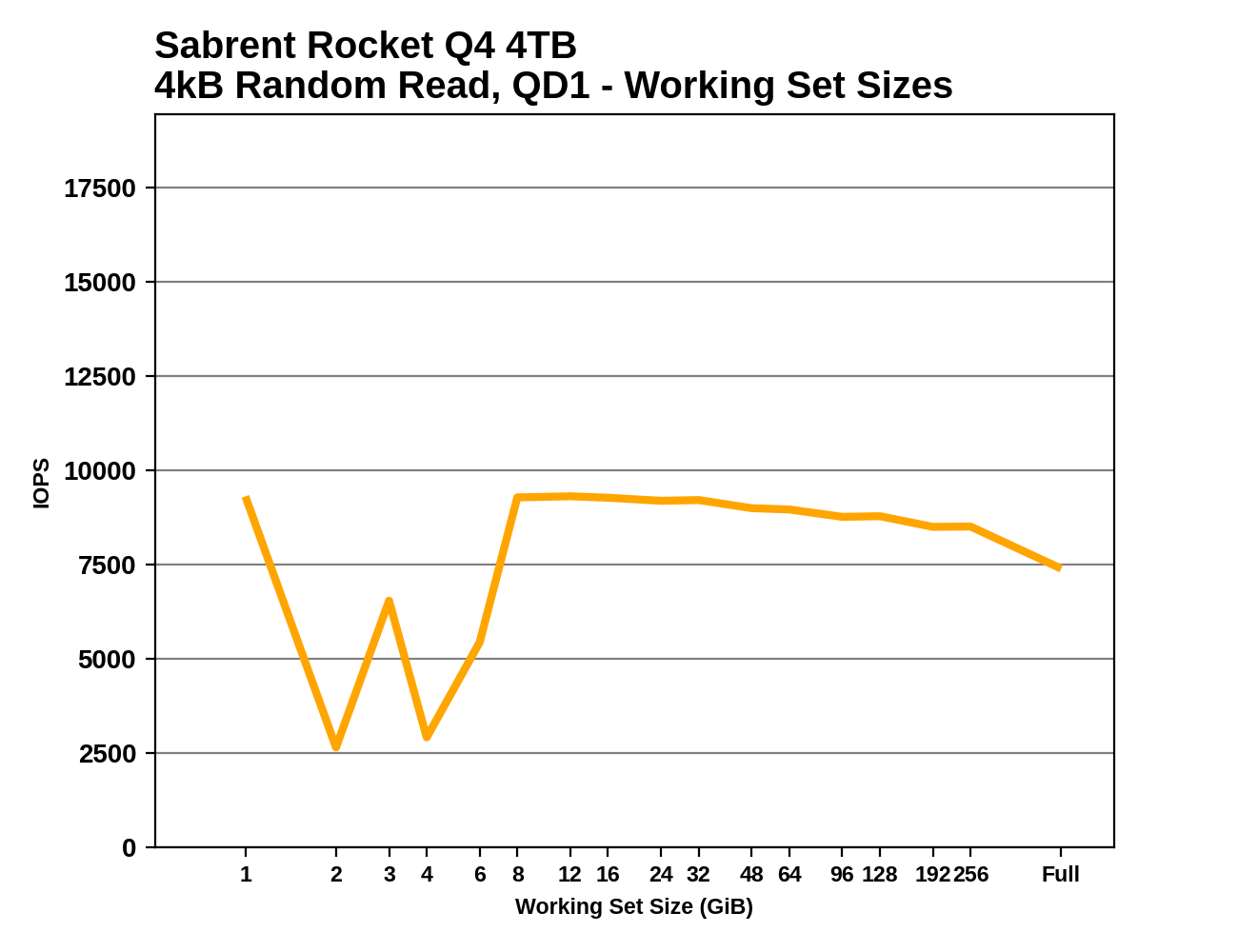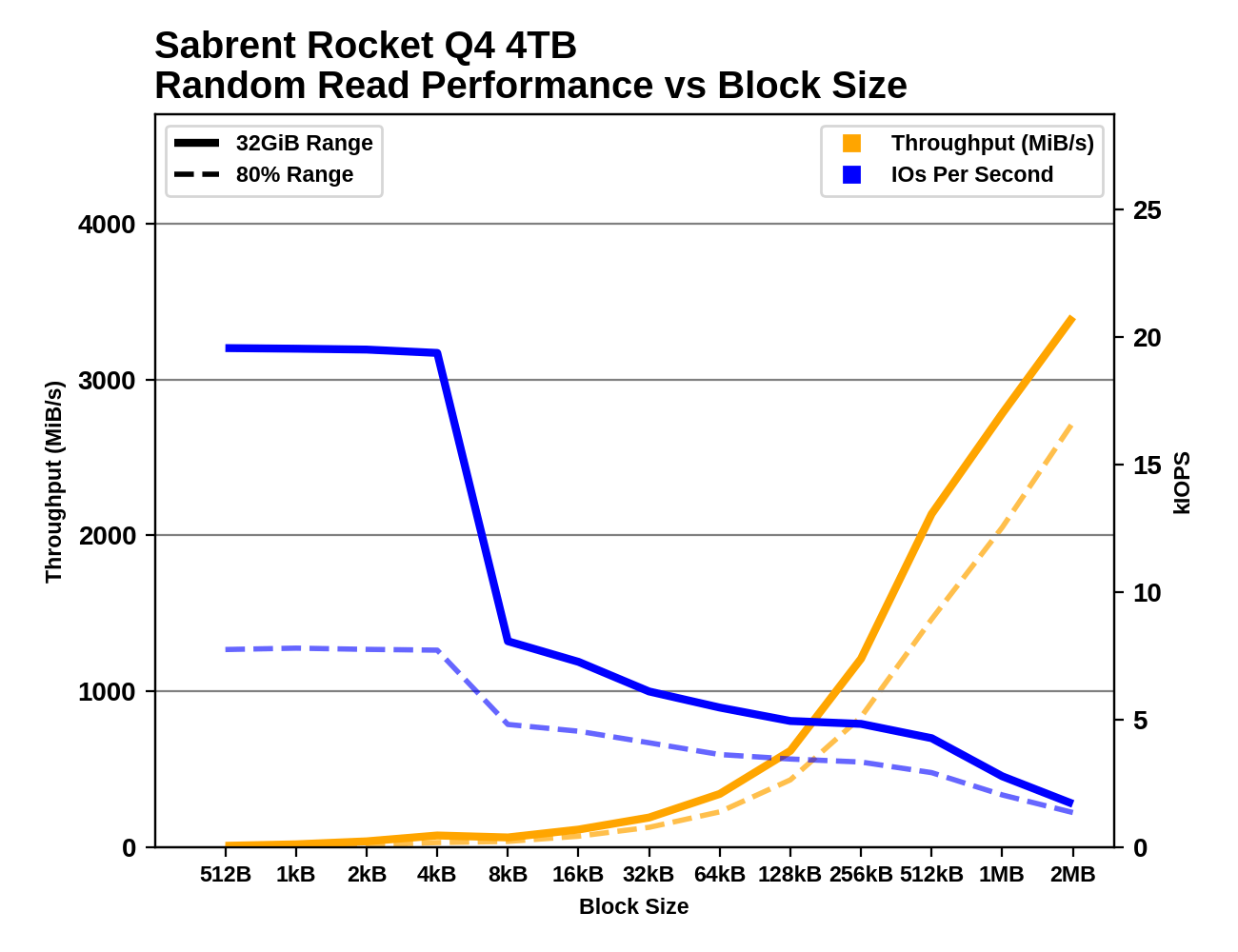Sabrent Rocket Q4 and Corsair MP600 CORE NVMe SSDs Reviewed: PCIe 4.0 with QLC
by Billy Tallis on April 9, 2021 12:45 PM ESTAdvanced Synthetic Tests
Our benchmark suite includes a variety of tests that are less about replicating any real-world IO patterns, and more about exposing the inner workings of a drive with narrowly-focused tests. Many of these tests will show exaggerated differences between drives, and for the most part that should not be taken as a sign that one drive will be drastically faster for real-world usage. These tests are about satisfying curiosity, and are not good measures of overall drive performance. For more details, please see the overview of our 2021 Consumer SSD Benchmark Suite.
Whole-Drive Fill
 |
|||||||||
| Pass 1 | |||||||||
| Pass 2 | |||||||||
As is typical for QLC drives based around Phison controllers, the SLC caches on the Rocket Q4 and MP600 CORE are as large as possible: about 1/4 the usable capacity of the drive. Write speeds to the cache hover around or just above the limit of what a PCIe 3 x4 link could handle, and once the cache is full performance drops down to well below the limit of what a SATA link could handle.
 |
|||||||||
| Average Throughput for last 16 GB | Overall Average Throughput | ||||||||
Both the 2TB MP600 CORE and the 4TB Rocket Q4 have about the same overall write speed, and they're in the middle of the pack of QLC drives: the older 8TB Rocket Q and the more recent Intel 670p both outperform the Phison E16 drives. And all of the TLC drives naturally sustain higher write speeds than any of these QLC drives.
Working Set Size
 |
|||||||||
Both the Rocket Q4 and MP600 CORE have some disappointing performance drops during the working set size test, suggesting there's background work keeping the drives busy despite all the idle time they get before the test and between phases of the test. But aside from that, we see the expected trends: the MP600 CORE has flat overall performance on account of having 2GB of DRAM for its 2TB of NAND, while the Rocket Q4 shows a slight performance decline for large working sets because it's managing 4TB of NAND with the same 2GB of DRAM.
Performance vs Block Size
 |
|||||||||
| Random Read | |||||||||
| Random Write | |||||||||
| Sequential Read | |||||||||
| Sequential Write | |||||||||
The two Phison E16 drives with QLC show similar patterns to the E12 QLC drives, but with substantial performance improvements in several places, most notable for random reads. These drives don't have any issues with block sizes smaller than 4kB, but there are performance drops at larger block sizes where the SLC cache runs out while testing random writes.










60 Comments
View All Comments
pdegan2814 - Wednesday, April 14, 2021 - link
The endurance rating of the standard MP600 is exactly why I bought it as well. It blows most other SSDs out of the water in that regard. And it's more than fast enough for my needs.ozzuneoj86 - Friday, April 9, 2021 - link
All I get from any SSD review lately is that SK Hynix needs to release a Gen4 drive, since their Gen3 drive leads by a good margin in many tests already. Unless you need more than 1TB on a single drive, there's not much reason to go with anything but the P31 (or the 980 Pro if money is no object). Very high efficiency (less power is less heat), high performance, high consistency (empty vs full) and competitively low price. The only thing preventing me from getting a P31 myself is that I'm sure they'll put out a Gen4 version before long, and unless they screw something up it should be among the best drives available.ozzuneoj86 - Friday, April 9, 2021 - link
Sorry, I forgot about the SN850 and 970 Pro... those are also competitive, but much more expensive.bernstein - Saturday, April 10, 2021 - link
The problem with the p31 is that it was never available. at least in europe. And there is no 2tb model...ozzuneoj86 - Sunday, April 11, 2021 - link
Sorry to hear they are hard to get in Europe. The P31 is very easy to get in the US for $135 and often goes on sale for less at Amazon.But I agree, not having a 2TB option is unfortunate.
Samus - Sunday, April 11, 2021 - link
We can get the 1TB regularly for (MSRP?) $130-$135 at retail and online in the USA, but as you and ozzuneoj said, not having a 2TB variety is a missed opportunity for Hynix because this has been my go-to drive for nearly a year in just about every upgrade I do (I use nothing else in laptops or SFF\ITX systems where the power efficiency and low heat are most beneficial)On top of that, I have installed dozens and zero have failed. An amazing accomplishment from Hynix. I've used the S31 in legacy systems with SATA ports and it's equally excellent especially for the price, though the MX500 is still my go-to drive for legacy systems because it is often slightly cheaper, and again, I have seen zero failures from those drives over the years.
Come on Hynix make a 2TB model already...
back2future - Sunday, April 11, 2021 - link
that's not the point for data retention . Having data on a SSD (nand flash, type slc, mlc, tlc, qlc) it would be necessary specification for customers (beside TBW) how to store SSDs or power cycle for long term data security?While having been impressed with performance (compared to non-raid HDD) since first time SSD experience, few information about long term data security is minor customer support on that item?
Hulk - Friday, April 9, 2021 - link
I'm pleasantly surprised by the very good performance metrics for these drives. The combination of 1/4 drive SLC cache with the "housekeeping" in the background makes for a fast, yet economical drive. I have a feeling prices on these will drop pretty quickly and they'll be a great buy in 6 months to a year. I don't think I'd use them in a laptop and I think I'd go 2TB or larger for the sake of performance and endurance though.shabby - Friday, April 9, 2021 - link
Quality(endurance) , price, performance... choose two. With qlc you can only choose one 🙄Hulk - Friday, April 9, 2021 - link
I'm not so sure about that. 225GB day written for 5 years for the 2TB drive. If you aren't in a server situation I don't know how you'd ever get near that number.